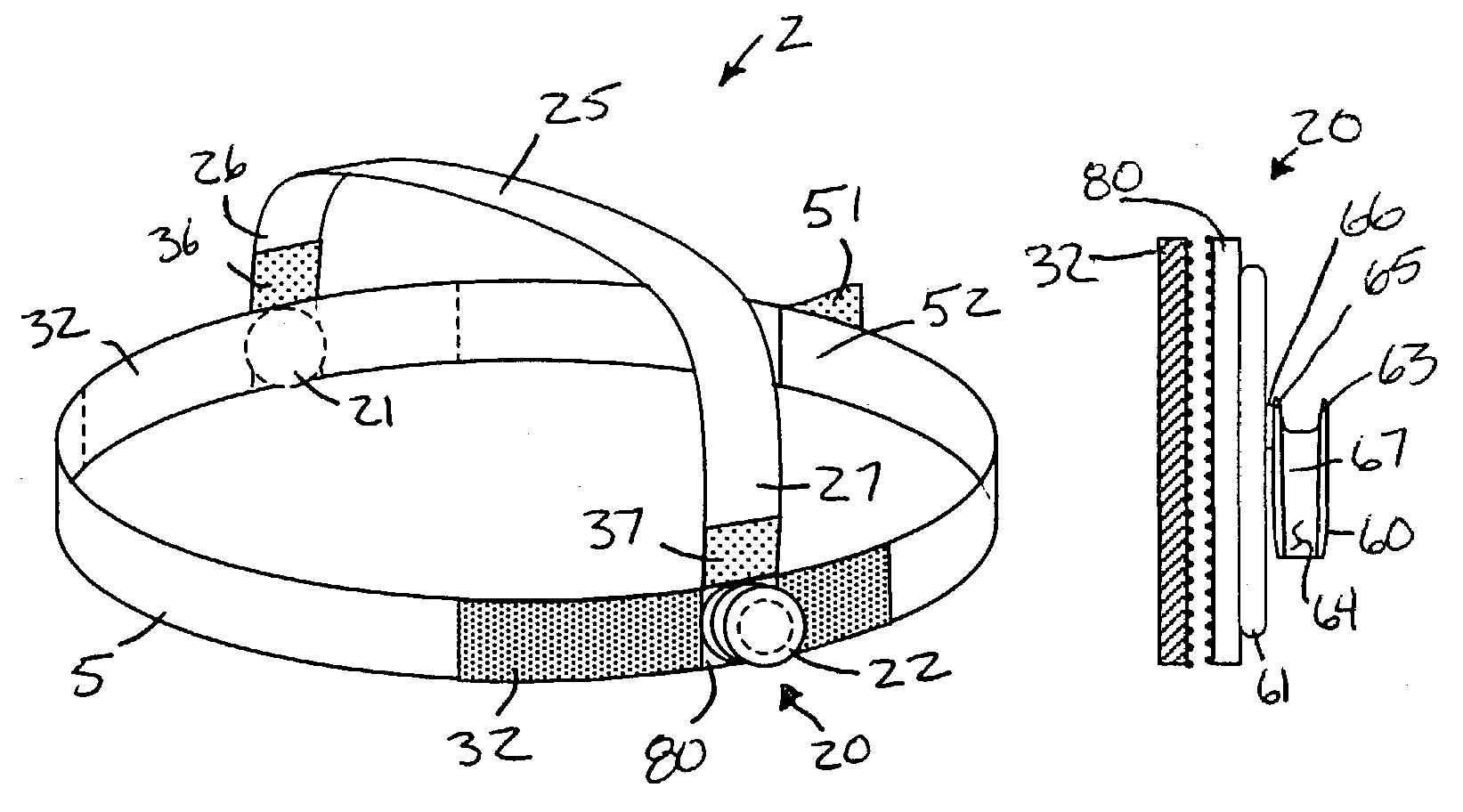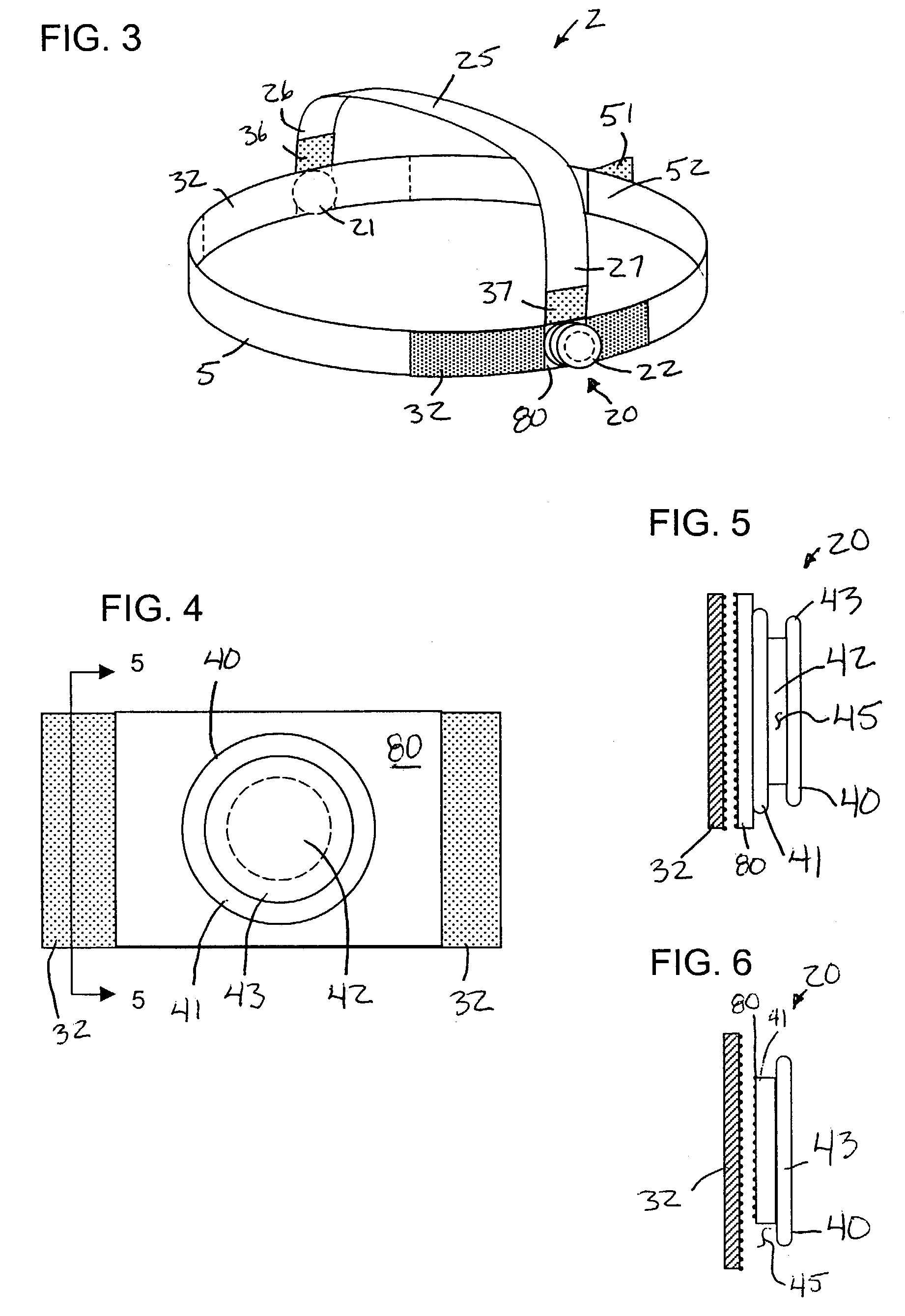While being one of the most convenient methods known to date for supplying a patient with a gas enriched environment, existing nasal cannulae suffer a major drawback: the positioning of the tubes around the ears for support is uncomfortable and can cause the patient chaffing and pain.
Additionally, existing nasal cannulae are prone to falling off the patient's face.
Patients regularly find that
body movement, especially during sleep, causes the cannula to dislocate, depriving the patient of the needed
oxygen enrichment.
Accidental removal of the cannula can also cause severe discomfort to the patient and in certain cases may even be life threatening.
The use of temples and
nose pads also makes this arrangement uncomfortable and not well suited for use while the wearer is sleeping.
U.S. Pat. No. 2,259,817, Hawkins, entitled “Adjustable Head Attachment for
Oxygen Tubes” discloses a support for cannula tubes having an adjustable temple band and an adjustable crown band These bands and associated buckles, together with the obtrusive
nose portion of the cannula tube also make this arrangement uncomfortable and unsuitable for sleeping.
That arrangement is not well suited for use while the wearer is sleeping.
In addition, some individuals who do not wear glasses for reasons of vision find glasses uncomfortable or awkward and would prefer another nasal cannula arrangement.
This arrangement is uncomfortable against the face and can block or impair ones vision.
This arrangement is uncomfortable in the
nasal passages and is not compatible with standard supply tubes.
The foam base, which extends across the face is bulky and can also be uncomfortable as well as obstructive.
Although meant to provide comfort, these devices still create chaffing and discomfort due to placement about the patient's ears.
This arrangement suffers from several disadvantages, major amongst them is the location of both oxygen tubes behind the patient's head where they may be blocked if the head is resting thereupon.
Additionally, placement of tubes behind the head is often uncomfortable to the patient.
Clark's preferred implementation is less desirable since the strap may slide over the head of the user and is liable to entangle with the patient's hair.
A problem with these inventions is that the elastic band runs the risk of entanglement in the patient's hair.
The major problem with the cannulas and retainers of the prior art is that they rub on the face and ears of a patient under extended use.
This
rubbing causes discomfort, chaffing, sores and infections, particularly in elderly patients and other with heightened sensitivity such as
chemotherapy patients.
The retainers and pads of the prior art are also obtrusive, uncomfortable and unattractive and do not particularly alleviate the chaffing of the
skin of the face and ears.
Another major problem with such prior art cannula occurs when the main
oxygen delivery tube which delivers oxygen to the cannula gets snagged on an object, which happens frequently during the course of a day for a mobile person such as when carrying or pulling a portable
oxygen tank or a person connected by a long main tube to a stationary
oxygen concentrator located in a house or
apartment.
When such
snagging occurs, the oxygen tubes are typically pulled downwardly such that the tension on the upper portions of the oxygen tubes is significantly increased jamming the nosepiece into the person's
nose causing much discomfort to such person and potential injury to the nose, ears, and face of the person.
Such
snagging also causes the upper portions of the respective oxygen tubes to move upwardly towards the person's eyes partially blocking the
field of view, which can be particularly hazardous while driving an automobile.
Another problem is that the retaining collars are prone to slip downwardly during cannula use such that the tension on the oxygen tubes is reduced.
Such loss of tension can cause the nosepiece to fall from the person's nose and the oxygen tubes to fall from around the person's ears.
This is particularly prone to occur when the person is asleep and is typically caused by tossing and turning of the person causing contact of the cannula and retaining collar against the
bed.
This activity disrupts the person's sleep particularly when occurring multiple times each night.
If the person does not awake, potentially serious hypoxia, including permanent
brain damage and death can occur due to the lack of sufficient
oxygen supply to the person's brain.
 Login to View More
Login to View More  Login to View More
Login to View More 


